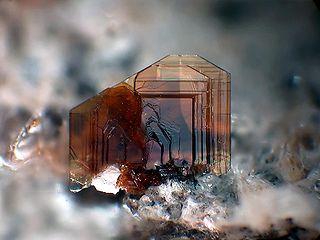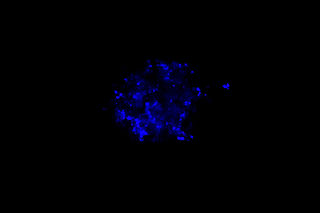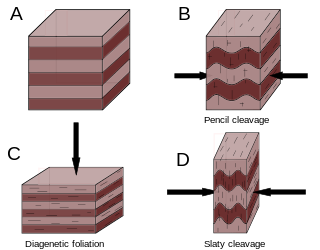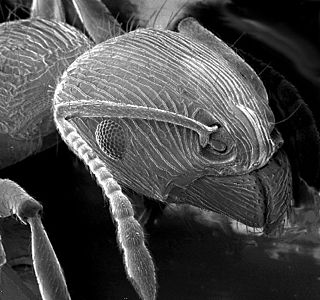
Biotite is a common group of phyllosilicate minerals within the mica group, with the approximate chemical formula K(Mg,Fe)3AlSi3O10(F,OH)2. It is primarily a solid-solution series between the iron-endmember annite, and the magnesium-endmember phlogopite; more aluminous end-members include siderophyllite and eastonite. Biotite was regarded as a mineral species by the International Mineralogical Association until 1998, when its status was changed to a mineral group. The term biotite is still used to describe unanalysed dark micas in the field. Biotite was named by J.F.L. Hausmann in 1847 in honor of the French physicist Jean-Baptiste Biot, who performed early research into the many optical properties of mica.

A waveplate or retarder is an optical device that alters the polarization state of a light wave travelling through it. Two common types of waveplates are the half-wave plate, which shifts the polarization direction of linearly polarized light, and the quarter-wave plate, which converts linearly polarized light into circularly polarized light and vice versa. A quarter-wave plate can be used to produce elliptical polarization as well.

Triboluminescence is a phenomenon in which light is generated when a material is mechanically pulled apart, ripped, scratched, crushed, or rubbed. The phenomenon is not fully understood, but appears to be caused by the separation and reunification of static electrical charges. The term comes from the Greek τρίβειν and the Latin lumen (light). Triboluminescence can be observed when breaking sugar crystals and peeling adhesive tapes.

Metamorphism is the transformation of existing rock to rock with a different mineral composition or texture. Metamorphism takes place at temperatures in excess of 150 °C (300 °F), and often also at elevated pressure or in the presence of chemically active fluids, but the rock remains mostly solid during the transformation. Metamorphism is distinct from weathering or diagenesis, which are changes that take place at or just beneath Earth's surface.
Extinction, in biology and palaeontology, is the end of a species or other taxon.

Crystal twinning occurs when two or more adjacent crystals of the same mineral are oriented so that they share some of the same crystal lattice points in a symmetrical manner. The result is an intergrowth of two separate crystals that are tightly bonded to each other. The surface along which the lattice points are shared in twinned crystals is called a composition surface or twin plane.

In optical mineralogy and petrography, a thin section is a thin slice of a rock or mineral sample, prepared in a laboratory, for use with a polarizing petrographic microscope, electron microscope and electron microprobe. A thin sliver of rock is cut from the sample with a diamond saw and ground optically flat. It is then mounted on a glass slide and then ground smooth using progressively finer abrasive grit until the sample is only 30 μm thick. The method uses the Michel-Lévy interference colour chart to determine thickness, typically using quartz as the thickness gauge because it is one of the most abundant minerals.

Optical mineralogy is the study of minerals and rocks by measuring their optical properties. Most commonly, rock and mineral samples are prepared as thin sections or grain mounts for study in the laboratory with a petrographic microscope. Optical mineralogy is used to identify the mineralogical composition of geological materials in order to help reveal their origin and evolution.

In geology, texture or rock microstructure refers to the relationship between the materials of which a rock is composed. The broadest textural classes are crystalline, fragmental, aphanitic, and glassy. The geometric aspects and relations amongst the component particles or crystals are referred to as the crystallographic texture or preferred orientation. Textures can be quantified in many ways. The most common parameter is the crystal size distribution. This creates the physical appearance or character of a rock, such as grain size, shape, arrangement, and other properties, at both the visible and microscopic scale.

Tectonites are metamorphic or tectonically deformed rocks whose fabric reflects the history of their deformation, or rocks with fabric that clearly displays coordinated geometric features that indicate continuous solid (ductile) flow during formation. Planar foliation results from a parallel orientation of platey mineral phases such as the phyllosilicates or graphite. Slender prismatic crystals such as amphibole produce a lineation in which these prisms or columnar crystals become aligned. Tectonites are rocks with minerals that have been affected by natural forces of the earth, which allowed their orientations to change. This usually includes recrystallization of minerals, and the foliation formation. Tectonites are studied through structural analysis and allows for the determination of two things:

Extinction is a term used in optical mineralogy and petrology, which describes when cross-polarized light dims, as viewed through a thin section of a mineral in a petrographic microscope. Isotropic minerals, opaque (metallic) minerals, and amorphous materials (glass) do not allow light transmission under cross-polarized light. Anisotropic minerals specifically will show one extinction for each 90 degrees of stage rotation.

Cleavage, in structural geology and petrology, describes a type of planar rock feature that develops as a result of deformation and metamorphism. The degree of deformation and metamorphism along with rock type determines the kind of cleavage feature that develops. Generally, these structures are formed in fine grained rocks composed of minerals affected by pressure solution.
A deformation mechanism, in geology, is a process occurring at a microscopic scale that is responsible for changes in a material's internal structure, shape and volume. The process involves planar discontinuity and/or displacement of atoms from their original position within a crystal lattice structure. These small changes are preserved in various microstructures of materials such as rocks, metals and plastics, and can be studied in depth using optical or digital microscopy.
This glossary of geology is a list of definitions of terms and concepts relevant to geology, its sub-disciplines, and related fields. For other terms related to the Earth sciences, see Glossary of geography terms.

Arthropods are covered with a tough, resilient integument or exoskeleton of chitin. Generally the exoskeleton will have thickened areas in which the chitin is reinforced or stiffened by materials such as minerals or hardened proteins. This happens in parts of the body where there is a need for rigidity or elasticity. Typically the mineral crystals, mainly calcium carbonate, are deposited among the chitin and protein molecules in a process called biomineralization. The crystals and fibres interpenetrate and reinforce each other, the minerals supplying the hardness and resistance to compression, while the chitin supplies the tensile strength. Biomineralization occurs mainly in crustaceans. In insects and arachnids, the main reinforcing materials are various proteins hardened by linking the fibres in processes called sclerotisation and the hardened proteins are called sclerotin. The dorsal tergum, ventral sternum, and the lateral pleura form the hardened plates or sclerites of a typical body segment.

Bird's eye extinction, or bird's eye maple, is a specific type of extinction exhibited by minerals of the mica group under cross polarized light of the petrographic microscope. It gives the mineral a pebbly appearance as it passes into extinction. This is caused when the grinding tools used to create petrographic thin sections of precise thickness alter the alignment of the previously perfect basal cleavage planes which split micas up into its characteristic thin sheets. The resulting, slightly roughened surface alters the extinction angle of various parts of the crystal lattice, leading to this type of extinction. Since it is not a natural feature of the mineral, bird's eye extinction is not observed in all mica crystals, nor from all angles, but it is quite common, and is used as a diagnostic feature for micas.
A conoscopic interference pattern or interference figure is a pattern of birefringent colours crossed by dark bands, which can be produced using a geological petrographic microscope for the purposes of mineral identification and investigation of mineral optical and chemical properties. The figures are produced by optical interference when diverging light rays travel through an optically non-isotropic substance – that is, one in which the substance's refractive index varies in different directions within it. The figure can be thought of as a "map" of how the birefringence of a mineral would vary with viewing angle away from perpendicular to the slide, where the central colour is the birefringence seen looking straight down, and the colours further from the centre equivalent to viewing the mineral at ever increasing angles from perpendicular. The dark bands correspond to positions where optical extinction would be seen. In other words, the interference figure presents all possible birefringence colours for the mineral at once.

Quartz is the most abundant single mineral in the earth's crust, and as such is present in a very large proportion of rocks both as primary crystals and as detrital grains in sedimentary and metamorphic rocks. Dynamic recrystallization is a process of crystal regrowth under conditions of stress and elevated temperature, commonly applied in the fields of metallurgy and materials science. Dynamic quartz recrystallization happens in a relatively predictable way with relation to temperature, and given its abundance quartz recrystallization can be used to easily determine relative temperature profiles, for example in orogenic belts or near intrusions.
Hendricksite is a member of the trioctahedral micas group. The mineral was named by Clifford Frondel and Jun Ito in honor of Sterling Brown Hendricks, who studied micas. It was approved in 1966 by the IMA.















